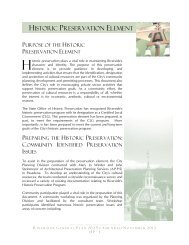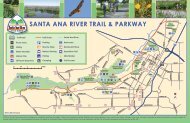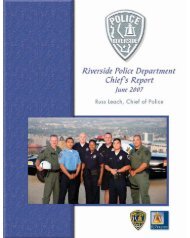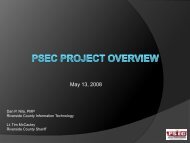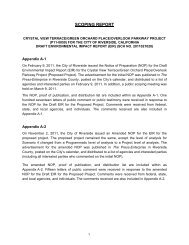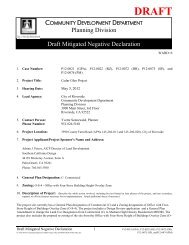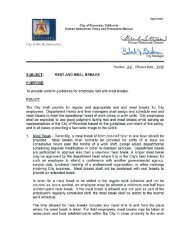Northside - City of Riverside
Northside - City of Riverside
Northside - City of Riverside
You also want an ePaper? Increase the reach of your titles
YUMPU automatically turns print PDFs into web optimized ePapers that Google loves.
HISTORY<br />
As WWI came to a close, America’s collective focus narrowed once more, and the<br />
quiet growth during the first decades <strong>of</strong> the 20 th century was called upon to support<br />
an unprecedented boost in regional population. The effects <strong>of</strong> the increase in oil<br />
production during and after WWI, the rising popularity <strong>of</strong> motion pictures, and the<br />
booming tourist trade all served to bring settlers and dollars into southern California<br />
and prompted the real estate boom <strong>of</strong> the 1920s and the development <strong>of</strong> southern<br />
California’s first suburbs. Approximately 1,440,000 new residents settled in southern<br />
California during the 1920s, an impact that was felt locally (McWilliams 1976:135-<br />
137).<br />
Though <strong>Riverside</strong>’s agricultural landscape slowly began to transform and shift<br />
interest to other agricultural products and industries, citrus remained the economic<br />
and cultural identity <strong>of</strong> the city. A shift, though, in the <strong>City</strong>’s dependence on<br />
agriculture and citrus can be seen in both residential and commercial/industrial<br />
development with the establishment <strong>of</strong> small- to large-scale family farms, mainly in<br />
portions <strong>of</strong> the <strong>Northside</strong> and in the Arlington area, and commercial/industrial<br />
interests are both diversified in terms <strong>of</strong> products and services and consolidated<br />
geographically. During this period, countywide citrus production and acreage was<br />
maintained or increased with the inclusion <strong>of</strong> new citrus production in Corona,<br />
Hemet-San Jacinto and Elsinore areas, even though local acreage was decreased in<br />
favor <strong>of</strong> other crops or urbanization (Patterson 1996:380-81). In addition, a shift in<br />
local labor groups from Japanese to Mexican workers reflected both America’s<br />
alliance with Japan during WWI and the effects <strong>of</strong> the end <strong>of</strong> the Mexican<br />
Revolution, which prompted large-scale immigration from the south.<br />
Though many Mexican immigrants must surely have settled in areas where<br />
residents <strong>of</strong> Mexican-American heritage were already established such as Casa<br />
Blanca and Arlington, some undoubtedly settled on the <strong>Northside</strong> as today, over<br />
half <strong>of</strong> <strong>Northside</strong> residents are Hispanic. Some residents and descendents <strong>of</strong> La<br />
Placita and Agua Mansa are believed to have settled in the <strong>Northside</strong> after the<br />
Spanish settlement declined. Despite the lack <strong>of</strong> evidence <strong>of</strong> <strong>Northside</strong> Hispanics in<br />
the historic record, other Spanish-speakers working as laborers and pr<strong>of</strong>essionals are<br />
listed in early city directories whose names match those known to be associated with<br />
the Spanish settlement like Garcia, Romo, and Pena (Bynon 1893-4:n.p.; Patterson<br />
1996:132).<br />
Though not on the <strong>Northside</strong>, public building continued elsewhere in the <strong>City</strong> with<br />
the construction <strong>of</strong> three junior high schools in the 1920s and the Municipal<br />
Auditorium (1928-29). Chain stores like JC Penney and Sears Roebuck & Company<br />
arrived in <strong>Riverside</strong>, and a motion picture studio was constructed about 1920. The<br />
1920s and 1930s saw the development <strong>of</strong> the fine arts in <strong>Riverside</strong> with the<br />
102



